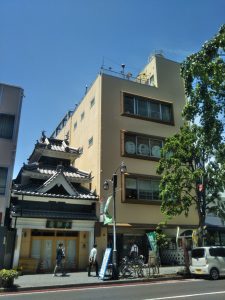History Hiding in Plain Sight: Honmachi & Daimyocho Streets
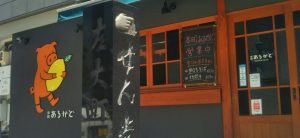
There’s this guy sitting on the northwest corner of an intersection in downtown Matsumoto. He’s holding a bamboo fishing rod in one hand and cradling a fish in the other. He has a terribly rugged complexion. He looks a bit sleepy.
He was cut from a pylon of stone.
Ebisu, the god of fisherman, merchants and farmers, is one of Japan’s Seven Gods of Fortune. He was placed here on March 3, 1991 to watch traffic and, more importantly, to bring commercial growth and success.
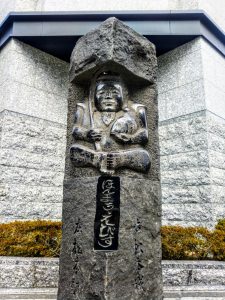
His name as inscribed in the rockface below his perch reads “Honmachi Ebisu” – a fantastic coincidence as the street to his left is called Honmachi-dori. As one of the main thoroughfares in town, Honmachi-dori runs all the way to Matsumoto Castle – and plays host to a wealth of Matsumoto’s castle town history. It’s easy to overlook the minor details of a place when there’s something like Matsumoto Castle up ahead, but take your time. There’s more to this place than meets the passive eye.

Okay, I admit that aside from our stone-faced, fish-holding friend, Honmachi-dori does not make a particularly memorable first impression; a few commercial buildings, a hotel, and the central post office make up most of the scenery. But then the diversions come quickly.
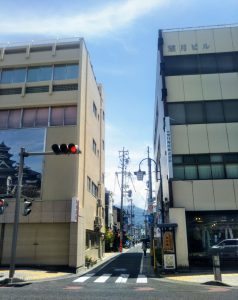
At the first intersection, a somewhat minor affair, turning left down ‘Koen-dori’ brings you between the PARCO department store and a concrete park and into a modest web of narrow streets filled mostly with restaurants, bars and karaoke. Turn right instead and you’ll find yourself on Takasuna-dori (高砂通り), also known as Ningyo-cho-dori (人形町通り).
For a conceptual glimpse of what lies down this narrow road, note that “ningyo” means doll. For a much fuller look check this post.
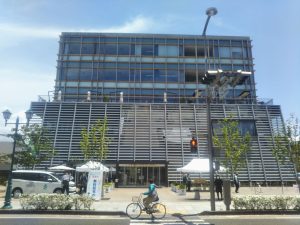
A few more steps along Honmachi-dori brings you to the T-intersection at Ise-machi-dori. Check out the Media Garden building opposite Ise-machi Street. There’s often something happening in the plaza out front. If not, head inside and escalate your way up to the third floor to the Matsumoto Brewery where you can grab a beer and chill out on the patio overlooking the streets below.
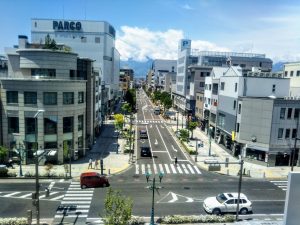
On the southwest corner of the Ise-machi-dori intersection there’s a stone pylon telling the quick story of the history of this spot. The characters on the south face say that turning left here puts you on the Nomugi Kaido, an old road established, it is said, in 1724. This road has had several names over the course of its 300 years, and has wound across the land in different places at different times. But its ultimate purpose has always been the same: to bring travelers over the Nomugi Pass and to Hida-Takayama, on the other side of the mountains.
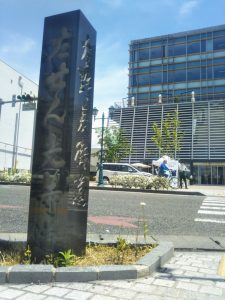
The characters etched on the pylon’s western face tell you to turn left for the Senkoji-do, the route that for centuries has led pilgrims and merchants to the city of Nagano and the temple of Zenkoji.
On the northwest corner is a marker of a different kind. The Ushi-tsunagi-ishi, “a stone to tie oxen to”, is pretty self-explanatory. A more detailed (and admittedly dubious) story pertaining to this seemingly revered rock is written in English as well as Japanese on the sign board to the left.
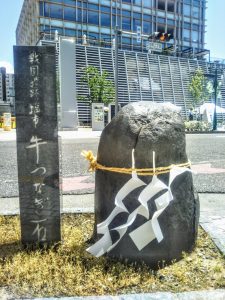
By the way, if you passed on a beer at the third-floor Matsumoto Brewery but still could use a drink, you have another option, just a few steps past the Ox Stone. Kadokko is a window over an outdoor counter where you can grab a bevvie right there on the sidewalk.
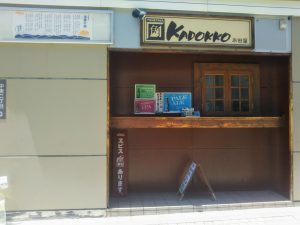
Stroll just a bit further (finish your drink first) and you’ll come to a pretty little alley called “Doshin-koji”. While the most common translation of ‘doshin’ is concentric, another reading of the word means “of the same mind”, which is a bit odd since the characters are most literally interpreted as “same heart”. Unfortunately for the romantic, in this case the first definition applies. In any case, ‘koji’ means alley.
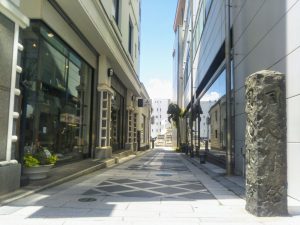
This little side street was named Concentric Alley in 1696 when Tadanao Mizuno, lord of Matsumoto Castle at the time, established a number of guard stations radiating out concentrically (more or less) from this spot, covering approximately ten different villages in the areas of Honmachi, Higashimiachi and Yasuhara for purposes of maintaining the security of the castle and protecting against fraudulent business transactions.
Today Matsumoto relies on more tested methods of public safety: small and numerous “Koban” police stations and strategically-placed statues of Ebisu.
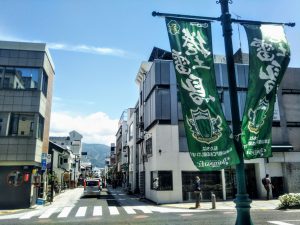
That side street on the other side of Honmachi-dori is Nakamachi-dori, Matsumoto’s old merchant district. Check this post for more info.
You might have already noticed (if you didn’t have too many at Kadokko) another stone pylon there on the corner of Nakamachi-dori. If the characters on the south face look familiar then you clearly didn’t have too much at Kadokko – they are the same as on that previous stone marker, pointing down Senkoji-do. On the southern face the characters tell you to turn left for the Omachi Kaido, part of the Shio Kaido, the “Salt Road”, which was the route merchants and traders took from Itoigawa on the Sea of Japan as they brought salt to places inland.
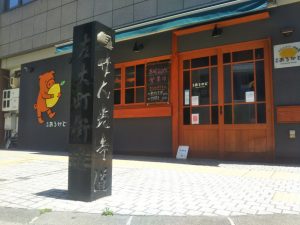
The Sensaibashi, the Thousand-Year Bridge spanning the Metoba River, marks the approximate halfway point between Honmachi Ebisu and Matsumoto Castle. Just downstream to the west stands the Matsumoto Timepiece Museum, rather recognizable for its massive pendulum clock, according to some sources the largest in Japan. Upstream to the east you can see the backs of the old wooden buildings that line Nawate-dori, the pedestrian lane running along the northern bank.
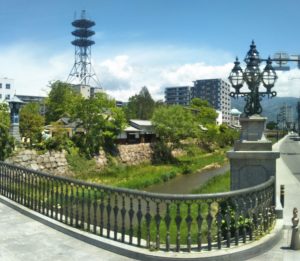
Over the bridge, Nawate-dori lies immediately to your right, Known rather affectionately as “Frog Street”, Nawate-dori has a long and interesting history. Here’s the story on that, along with some insight into the Yohashira Shrine next door.
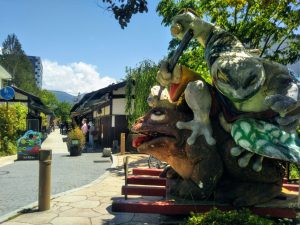
North of Sensaibashi Bridge, Honmachi-dori becomes Daimyocho-dori. In feudal Japan it was the daimyo who wielded local control, enjoying tremendous power as far back as the 10th Century. Four hundred years ago the southern wall of Matsumoto Castle reached all the way to this spot, once marked by the Ote-mon gate, the main entrance to the castle grounds.
Rather than a single gated entranceway, Ote-mon was a ‘masu-gata’ – a square enclosure with two gates that sat out of line relative to each other, forcing the attacking army to turn on itself, adding an extra element of defense. Note how, just over the bridge, Daimyocho-dori bends right then left. The way through Ote-mon’s masa-gata followed the same path.
Matsumoto Castle’s Kuro-mon and Taiko-mon gates are both built in this masa-gata style. Check them out when you go.
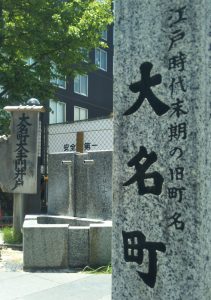 Inside the Ote-mon gate was the san-no-maru, the third ring or enclosure of the castle grounds. In this area was where the samurai lived. The daimyo lived in the hon-maru, the innermost garden – that is, until his residence burned down and he was forced to occupy the administrative buildings of the ni-no-maru, the second inner garden. The road leading from the marked the entrance to the castle, only the daimyo, his high-ranking officials, and the lord’s samurai could enter. The road leading from the Ote-mon gate to the entrance to the ni-no-maru was the path the daimyo took to reach his quarters. Through the time of the Mizuno clan (1642-1725) this street was called Ote-Nanmon-dori, the Ote South Gate Street.
Inside the Ote-mon gate was the san-no-maru, the third ring or enclosure of the castle grounds. In this area was where the samurai lived. The daimyo lived in the hon-maru, the innermost garden – that is, until his residence burned down and he was forced to occupy the administrative buildings of the ni-no-maru, the second inner garden. The road leading from the marked the entrance to the castle, only the daimyo, his high-ranking officials, and the lord’s samurai could enter. The road leading from the Ote-mon gate to the entrance to the ni-no-maru was the path the daimyo took to reach his quarters. Through the time of the Mizuno clan (1642-1725) this street was called Ote-Nanmon-dori, the Ote South Gate Street.
Daimyocho-dori, though no longer home to any samurai, holds plenty of understated appeal. A couple of the natural wells scattered around downtown Matsumoto can be found right there along the sidewalks.
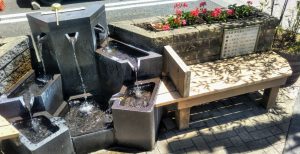
The designs on these metal-and-plastic pylon-ish things are the crests of the six daimyo families who, at different times, called Matsumoto Castle home.
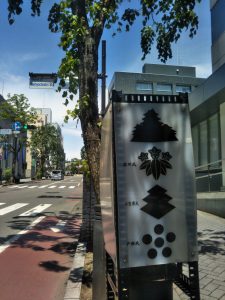
Dosojin, stone statues of elderly couples embracing, can be found all over the Shinshu region.
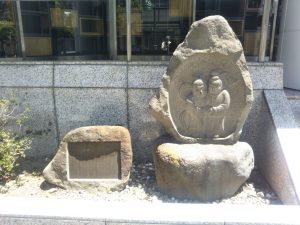
There are shops boasting intrigue both inside and out.

And, if you still want to know more, you can duck into the Tourist Information Center, one block away from the castle entrance.
Honmachi Ebisu, by the way, sits on the northwest corner of the intersection of Honmachi-dori and Agata-no-mori-dori, the street running straight east from the front of the station. Keep your eyes peeled as you make your way. You never know what else you might find.
